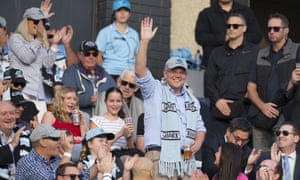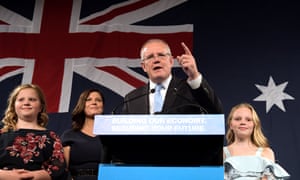The prime minister has snatched victory from the jaws of defeat, but to keep his election promises he’ll need a second miracle
Australia has roiled for three years, only to end up back where it started when the former prime minister Malcolm Turnbull
won the 2016 election by one seat. The Liberal National Coalition is
back in power in Canberra, with a new leader, Scott Morrison. Morrison
could govern with a two-seat majority. Perhaps three.
Normally this sort of election performance – holding office with a national swing of under 1% – would be considered pretty underwhelming. Turnbull scraping back into power in 2016 was considered a disaster large enough to trigger a comprehensive internal party review.
But Morrison is the hero of the hour, because he has managed to snatch victory from the jaws of defeat. After the weekend election result, the Liberal leader was cast by one Murdoch-owned national newspaper as the “Messiah from the Shire” because the Coalition was widely expected to lose office on 18 May. All the indicators over a long period of time pointed to a Labor victory in 2019, but the major national opinion polls were wrong. The betting markets – often highly reliable – were wrong.
This was an unusual contest. Labor, because of its long ascendancy in
the polls, its fleshed out policy program and the long history of
disunity on the other side, entered the election almost as if they were
the incumbents, not the challengers.Normally this sort of election performance – holding office with a national swing of under 1% – would be considered pretty underwhelming. Turnbull scraping back into power in 2016 was considered a disaster large enough to trigger a comprehensive internal party review.
But Morrison is the hero of the hour, because he has managed to snatch victory from the jaws of defeat. After the weekend election result, the Liberal leader was cast by one Murdoch-owned national newspaper as the “Messiah from the Shire” because the Coalition was widely expected to lose office on 18 May. All the indicators over a long period of time pointed to a Labor victory in 2019, but the major national opinion polls were wrong. The betting markets – often highly reliable – were wrong.
Palmer insurgency
Its leader, Bill Shorten, faced tougher scrutiny from the media and, consistent with the strange sense of the challengers being the incumbents in the contest, the protest vote against the status quo bled elsewhere. It went to the far-right One Nation party and to the political shopfront established by the controversial businessman Clive Palmer rather than to Labor.Palmer behaved like a cashed-up third-party activist in the contest, amplifying the Coalition’s negative messaging about Labor with a saturation advertising program estimated at $60m, and then funnelled the protest vote back to the Coalition through preferences. Labor suffered this problem most acutely in the state of Queensland, losing more than 3% of its primary vote to protest parties, which then flowed to the Coalition in preferences.

Disaffection with politics was palpable in every region of the country we visited over the five-week campaign. But there was a nuance in how the backrooms of the major party campaigns viewed voter disaffection, and that distinction proved important.
Bill Shorten, a Labor leader not well liked by Australian voters, was making an ambitious case for changing the country, hoping to tap into community frustration with national politics, which had been engaged in a decade-long war with itself, churning through prime ministers and struggling to compromise on policies, meaning progress was fitful.
Back to the future
The Liberals saw the terrain differently. There was a mood for change, certainly, but what voters wanted in the seats that would determine the election result was better government, not necessarily a change of government. The view inside the Liberal campaign was Australian voters, if they were engaged sufficiently to reflect on these questions, were craving a return to pre-2007 politics, where the tempo was calmer, the battle of ideas was conducted at a manageable volume, and where party leaders weren’t overthrown every other year.This subtle distinction gave the Coalition a way of projecting their own change message. The change Morrison projected wasn’t about revolution, it was about regression to a place of steadiness, about harking back to the political era that existed before the massive technological disruption of the internet – a time Australians now view with a certain level of nostalgia.
Given the Coalition’s level of internal instability over its two terms in office – two prime ministers felled in leadership coups and major internal battles about a range of issues, most notably climate change – it was a significant feat of marketing to present itself as the stability option. But there was a way to thread that needle, and the boldness of Labor’s policy offering along with Shorten’s regular invocations about the need to change the country assisted with the subliminal pitch.
Morrison also appealed to the “quiet Australians” – the off-grid folks – and by off-grid folks I don’t mean the environmentalists increasingly desperate about the outlook for the planet. I mean people consciously outside the fractious and pumped up Australian political conversation, getting about their business with a certain amount of bemusement about the hyperbolic antics in the capital and the accompanying clicktivism that thunders through social media.
The point of Morrison’s call to action was broadly the same as it was for Richard Nixon in the late 1960s when he spoke to the silent majority.
Antidote to urgency
Morrison’s intention was to style himself as a political leader outside the prism of activism; a leader who would have the intention of keeping politics off the front page and out of people’s faces. The Liberal leader presented himself as an antidote to the urgency of the contemporary political age, a meat and three veg politician who would, broadly speaking, keep things as they are rather than increase the operational tempo, or force anyone to surrender their privilege in the national interest.The question for the coming term – apart from whether that offering is right for the country, given the challenges Australia faces, and whether Morrison’s campaign spin actually matches the substance of what his government does over the next three years – is whether this is a fiction any political leader can sustain.
No political leader of our age has been able to levitate calmly above the cacophony, to steady the intemperate spirits of public discussion sufficiently to be able to exercise any real hegemony in the discourse – and every Australian leader, from Julia Gillard to Tony Abbott and Malcolm Turnbull, has tried to crack this particular code in one way or another.
As the winner of the unwinnable election, and a self-confessed believer in miracles, Morrison will fancy himself the political leader with the perfect skill set to execute this reverse time travel to the land of relaxed and comfortable.
But first he has to return to the punishing task of governing, with the first order of business navigating the economic headwinds that seem at odds with optimistic budget forecasts that underpin the Coalition’s enormously expensive tax cuts; deliver a promised surplus, and not cut spending. Given the prime minister spent a campaign arguing these propositions weren’t internally contradictory that may prove some task.

No comments:
Post a Comment